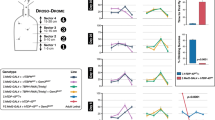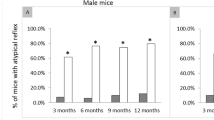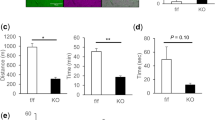Abstract
Mice that are homozygous with respect to the progressive motor neuronopathy (pmn) mutation (chromosome 13) develop a progressive caudio-cranial degeneration of their motor axons from the age of two weeks and die four to six weeks after birth1. The mutation is fully penetrant, and expressivity does not depend on the genetic background. Based on its pathological features, the pmn mutation has been considered an excellent model for the autosomal recessive proximal childhood form of spinal muscular atrophy (SMA). Previously, we demonstrated that the genes responsible for these disorders were not orthologous2,3. Here, we identify the pmn mutation as resulting in a Trp524Gly substitution at the last residue of the tubulin-specific chaperone e (Tbce) protein that leads to decreased protein stability. Electron microscopy of the sciatic and phrenic nerves of affected mice showed a reduced number of microtubules, probably due to defective stabilization. Transgenic complementation with a wildtype Tbce cDNA restored a normal phenotype in mutant mice. Our observations indicate that Tbce is critical for the maintenance of microtubules in mouse motor axons, and suggest that altered function of tubulin cofactors might be implicated in human motor neuron diseases.
This is a preview of subscription content, access via your institution
Access options
Subscribe to this journal
Receive 12 print issues and online access
$209.00 per year
only $17.42 per issue
Buy this article
- Purchase on Springer Link
- Instant access to full article PDF
Prices may be subject to local taxes which are calculated during checkout






Similar content being viewed by others
Accession codes
References
Schmalbruch, H.M.D., Jensen, H., Bjearg, M., Kamienniecka, Z. & Kurland, L.B.S. A new mouse mutant with progressive motor neuronopathy. J. Neuropathol. Exp. Neurol. 50, 192–204 (1991).
Bueno Brunialti, A.L., Poirier, C., Schmalbruch, H. & Guénet, J.-L. The mouse mutation progressive motor neuronopathy (pmn) maps to chromosome 13. Genomics 29, 131–135 (1995).
Viollet, L. et al. cDNA isolation, expression, and chromosomal localization of the mouse survival motor neuron gene (Smn). Genomics 40, 185–188 (1997).
Martin, N., Jaubert, J., Glaser, P., Szatanik, M. & Guénet, J.-L. Genetic and physical delineation of the region overlapping the progressive motor neuronopathy (pmn) locus on mouse chromosome 13. Genomics 75, 9–16 (2001).
Radcliffe, P.A., Hirata, D., Vardy, L. & Toda, T. Functional dissection and hierarchy of tubulin-folding cofactor homologues in fission yeast. Mol. Biol. Cell 10, 2987–3001 (1999).
Lewis, S.A., Tian, G., Vainberg, I.E. & Cowan, N.J. Chaperonin-mediated folding of actin and tubulin. J. Cell Biol. 132, 1–4 (1996).
Tian, G. et al. Pathway leading to correctly folded β-tubulin. Cell 86, 287–296 (1996).
Grishchuk, E.L. & McIntosh, J.R. Sto1p, a fission yeast protein similar to tubulin folding Cofactor E, plays an essential role in mitotic microtubule assembly. J. Cell Science 112, 1979–1988 (1999).
Gurney, M.E. et al. Motor neuron degeneration in mice that express a human Cu, Zn superoxide dismutase mutation. Science 264, 1772–1775 (1994).
Hoyt, M.A., Macke, J.P., Roberts, B.T. & Geiser, J.R. Saccharomyces cerevisiae PAC2 functions with CIN1, 2 and 4 in a pathway leading to normal microtubule stability. Genetics 146, 849–857 (1997).
Fleming, J.A., Vega, L.R. & Solomon, F. Function of tubulin-binding proteins in vivo. Genetics 156, 69–80 (2000).
Hirokawa, N. Microtubule organization and dynamics dependent on microtubule-associated proteins. Current Opinion in Cell Biology 6, 74–81 (1994).
Hunter, A.W. & Wordeman, L. How motor proteins influence microtubule polymerisation dynamics. J. Cell Science 113, 4379–4389 (2000).
Parvari, R. et al. Mutation of TBCE causes hypoparathyroidism–retardation–dysmorphism syndrome and autosomal recessive Kenny–Caffey Syndrome. Nature Genet. 32, 448–442 (2002).
Mucke, L. et al. Synaptotrophic effects of human amyloid beta protein precursors in the cortex of transgenic mice. Brain Res. 666, 151–167 (1994).
Acknowledgements
We thank C. Babinet, M. Cohen-Tannoudji and C. Henderson for helpful advice, J. Segre for critical reading of our manuscript, U. Maskos for providing the pNSE plasmid, L. Salas-Cortes for assistance in cell culture and V. Guyot for generation of transgenic mice. This work was supported by grants from the Association Française contre les Myopathies. N.M. benefited from a fellowship of the Association Française contre les Myopathies.
Author information
Authors and Affiliations
Corresponding author
Ethics declarations
Competing interests
The authors declare no competing financial interests.
Rights and permissions
About this article
Cite this article
Martin, N., Jaubert, J., Gounon, P. et al. A missense mutation in Tbce causes progressive motor neuronopathy in mice. Nat Genet 32, 443–447 (2002). https://doi.org/10.1038/ng1016
Received:
Accepted:
Published:
Issue Date:
DOI: https://doi.org/10.1038/ng1016
This article is cited by
-
Axon Biology in ALS: Mechanisms of Axon Degeneration and Prospects for Therapy
Neurotherapeutics (2022)
-
Dysregulation of a novel miR-1825/TBCB/TUBA4A pathway in sporadic and familial ALS
Cellular and Molecular Life Sciences (2018)
-
TBCD may be a causal gene in progressive neurodegenerative encephalopathy with atypical infantile spinal muscular atrophy
Journal of Human Genetics (2017)
-
Neurofilament depletion improves microtubule dynamics via modulation of Stat3/stathmin signaling
Acta Neuropathologica (2016)



